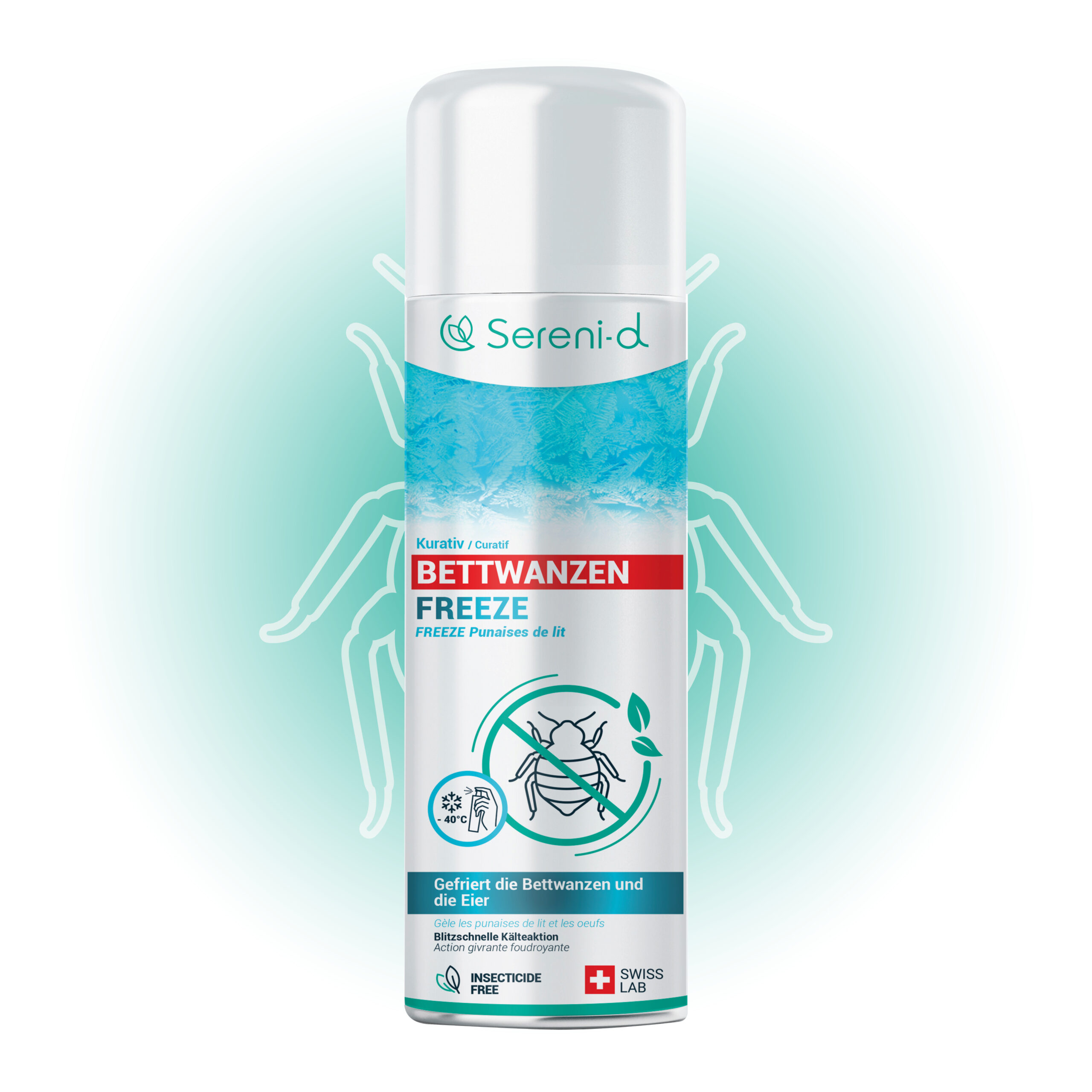Do you have suspicious marks and stains in your bedding? Feces near the skirting boards? You may have bed bugs in your home. We don’t need to remind you, but this little pest, also known as ‘Cimex lectularius’, is often very difficult to live with on a daily basis. Early detection is therefore essential to avoid any proliferation. Here’s a practical guide to identifying the different types of marks and stains and spotting the presence of bed bugs in your home. You’ll also find a list of effective treatments for eradicating them.
Bed bug traces and stains: key information
- Bed bugs leave bloodstains on sheets, black excrement on mattresses, skirting boards and furniture, as well as whitish eggs and moults.
- In the event of heavy infestation, a sweet or musty smell, due to bed bugs’ pheromones, can be smelled.
- When in doubt, canine detection is a fast and reliable technique for confirming the presence of bed bugs, by precisely targeting infested areas thanks to the exceptional sense of smell of trained dogs.
- The main treatments and prevention methods are: Steam cleaning, use of bedbug covers, natural insecticides such as diatomaceous earth, and rigorous cleaning of bedding and nooks and crannies.
How can you recognise traces of bed bugs?
Bed bug droppings and excrement
Bed bug droppings are one of the most telling signs of an infestation. These harmful insects feed exclusively on human blood, and their excrement, composed of digested blood residue, leaves characteristic traces.
Here’s how to identify them:
- Appearance: Droppings appear in the form of small black or brown spots, similar to ink blots. They are usually clustered near areas where bedbugs hide: mattresses, box springs, the seams of sheets or skirting boards.
- Location: Look for these marks around mattress seams, on pillows, in the crevices of the box spring, or on furniture close to the bed. These stains can also be found on walls or behind the headboard.
- Texture: Excrement is dry and spreads slightly when rubbed with a damp cloth, leaving a brownish mark.
The droppings are often accompanied by dead bedbug skins or whitish eggs. These are very revealing signs of an infestation.
Practical tip: If you find these marks, don’t ignore them. Vacuum the affected areas immediately, then use a high-temperature steam cleaner (minimum 100°C) to decontaminate thoroughly, and apply our FREEZE aerosol.
➡️ To find out more: The complete bed bugs protocol.
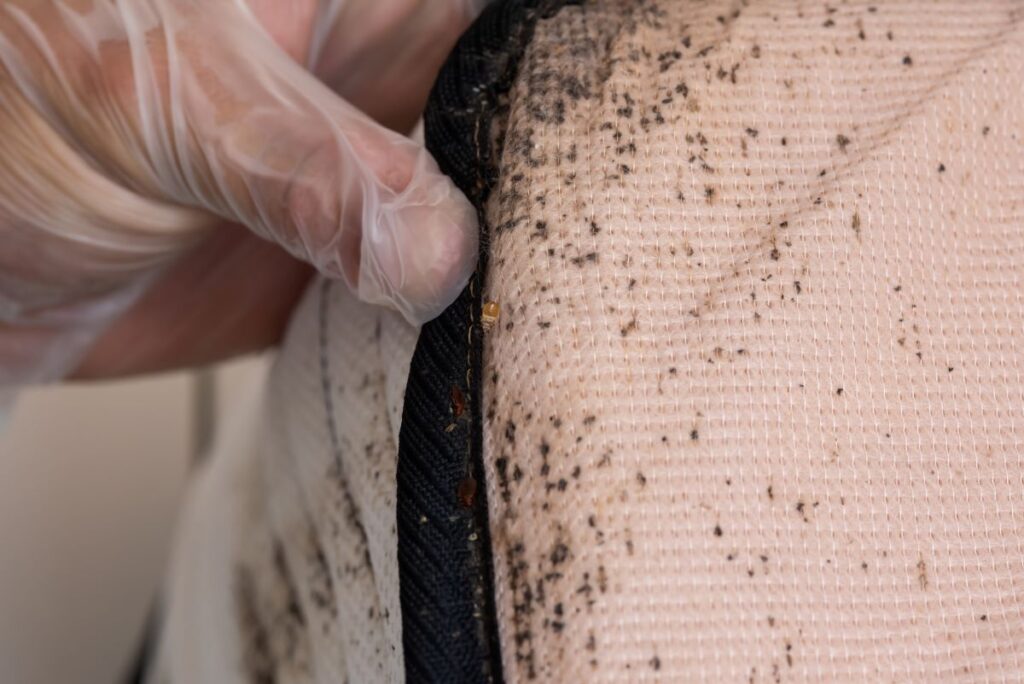
Traces of blood on bedding
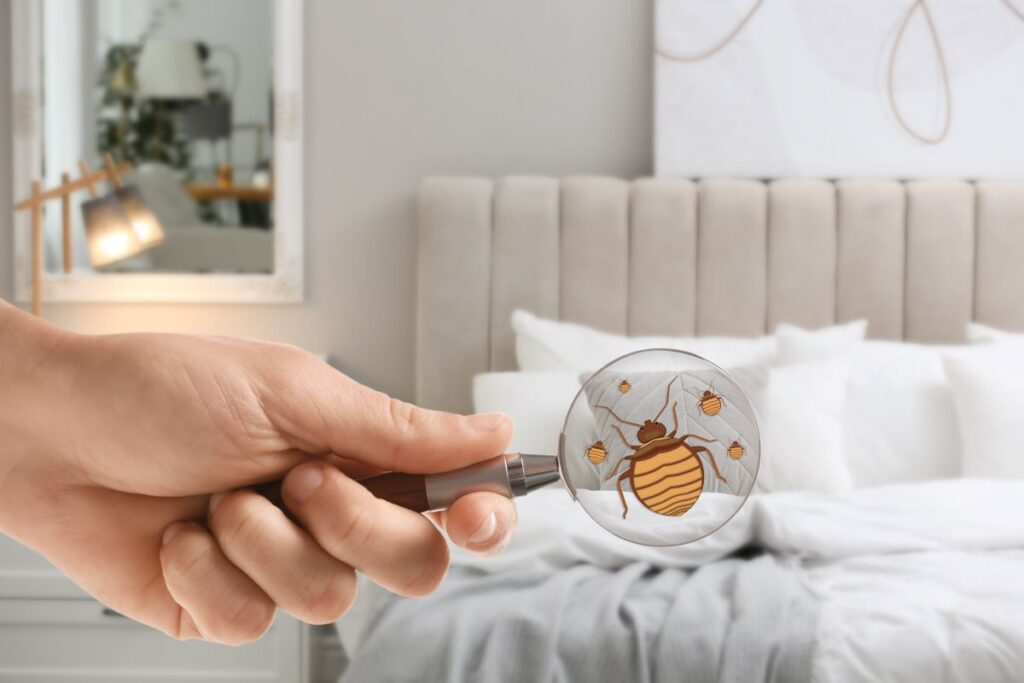
Bed bugs often leave traces of blood on sheets, covers and bedding. These bloodstains are small, bright red or dark brown, and located around the areas where you sleep.
At night, if you move around while you’re asleep, it’s common to crush bedbugs that are full of blood after their meal.
What’s more, a bedbug can absorb up to twice its own weight. When it has eaten too much, it can leave a trail of blood behind.
How do you clean bloodstains from bedding?
- Act quickly: As soon as you spot a stain, treat it immediately before it dries, as fresh stains are easier to remove.
- Use cold water: Soak the affected area in cold water. Avoid hot water, which can set the stain.
- Apply bicarbonate of soda: Prepare a paste with bicarbonate of soda and a little water, apply it to the stain and leave for 30 minutes before rinsing.
- Mild soap or stain remover: Apply a mild soap or stain remover specifically for blood stains (such as percarbonate-based products). Scrub gently with a soft bristle brush.
- Wash at high temperature: Put stained clothes in the washing machine at 60°C to remove all traces of stain and reduce the risk of parasites spreading.
- Natural option: You can also use white vinegar or lemon juice.
Use a bed bugs with mattress cover
You can protect your bedding with a special bed bugs with mattress cover. Similar to an anti-dust mite cover, it’s made from a multi-layered non-woven fabric. It forms a total barrier against bed bugs trapped inside. Some covers guarantee a micron-level seal for total protection.
Other signs of infestation

Bites and pimples
How can you recognise bed bug bites?
Bites are often concentrated in areas uncovered during sleep, such as the arms, legs, neck and face.
In terms of appearance, they take the form of small red pimples, often grouped together in a straight line or in clusters, and cause severe itching.
The itching and redness may persist for several days, or even a week, depending on the person’s sensitivity.
➡️ For more information: Bed bug bites: recognising and treating them.
No visible stings?
Some people do not react to bed bug bites because they have no allergic reaction. This can delay detection of an infestation.
Bites alone are not always enough to confirm an infestation. They need to be cross-checked with other clues, such as traces of blood on bedding, droppings or bed bug eggs in the nooks and crannies of the bedroom.
Difference from other insect bites
- Mosquitoes: Mosquito bites are often isolated and larger, with immediate itching.
- Fleas: Fleas generally bite around the ankles and leave slightly raised spots.
- Mites: They cause diffuse redness, accompanied by constant irritation, rather than well-defined pimples.
- Pyemotes and scleroderms: These insects can also cause red pimples, but their bites are less frequent and occur on contact with infested textiles or grain.
What should you do if you are bitten by bed bugs?
- Do not scratch to avoid aggravating the itching or causing an infection
- Apply a soothing roll-on such as ROLL ON Serenid
- Wash the area with warm water and mild soap
- Consult a doctor if necessary
➡️ See also: How can you relieve bed bug bites?
Bed bug eggs
Bed bug eggs and moults are clear signs of an infestation in your home. These traces are often left in places where bedbugs hide between their blood meals, such as bedding, cracks and dark nooks and crannies.
How can you recognise bed bug eggs?
- Size and appearance: Bed bug eggs measure around 1 millimetre, are white or translucent in colour and have an elongated, slightly oval shape. They look like small grains of rice.
- Location: They are generally found in the seams of mattresses, cracks in furniture, skirting boards and under bedsprings. Female bed bugs lay their eggs in hard-to-reach places.
- Number: A female can lay 5 to 7 eggs a day, with a total capacity of 200 to 500 eggs in her lifetime, which can quickly worsen an infestation.
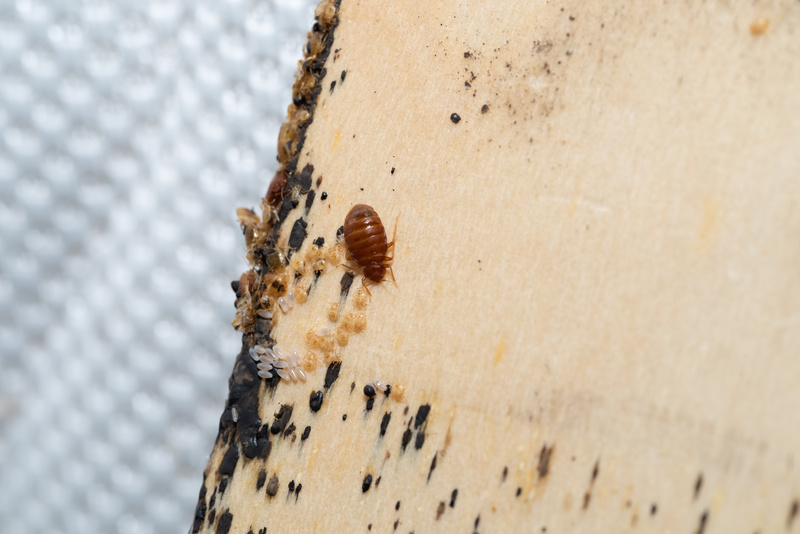
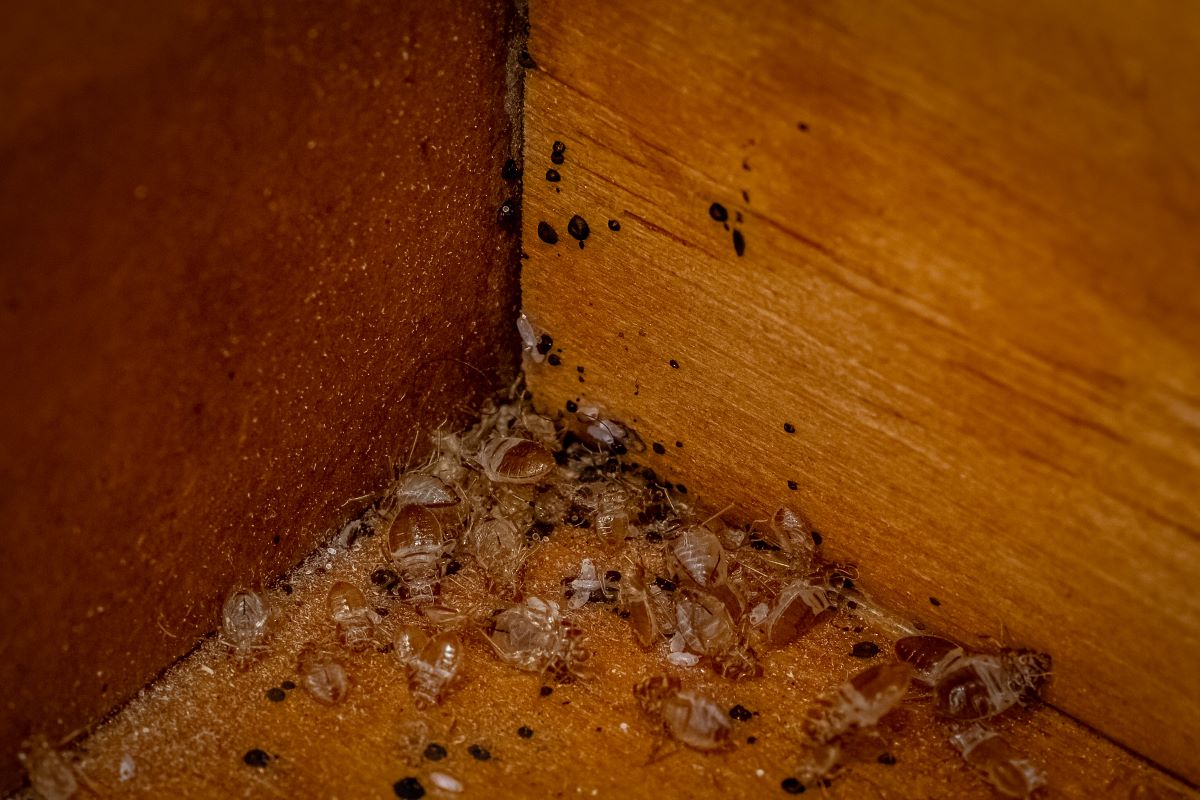
Bed bug moults
Molts are the exoskeletons left behind by bed bugs as they grow from nymphs to adults.
They are light brown or translucent in colour and resemble immobile but empty bedbugs.
Like eggs, they are often found in bedbugs’ favourite hiding places, such as mattress seams, furniture crevices and dark corners.
What should you do if you find bed bug eggs or moults?
- Vacuum infested areas, paying particular attention to mattress seams and crevices.
- Use a high-temperaturesteam cleaner (at least 120°C) to kill the eggs.
- Sprinkle diatomaceous earth in strategic nooks and crannies to prevent the eggs from hatching.
- Follow up with a natural insecticide treatment such as Serenid spray.

SOS BEDBUGS SPRAY
24,90 €
- Eliminates 100% of bed bugs (eggs, larvae, adults)
- Immediate, safe and long-lasting protection
- Over 50,000 satisfied Sereni-d® customers
The smell of bed bugs
One of the often overlooked but telling signs of a bed bug infestation is the distinctive odour they can give off.
Bed bugs give off a slightly sweet smell, sometimes compared to berries or a musty odour. This smell comes from their pheromones.
In the event of an advanced infestation, the smell becomes stronger due to the large number of bedbugs present and the accumulation of their faeces and excrement.
This odour is generally concentrated in areas where they hide, such as
- The seams of mattresses and pillows
- Cracks and nooks in furniture or walls
- Skirting boards and carpets near beds
- Box springs or headboards
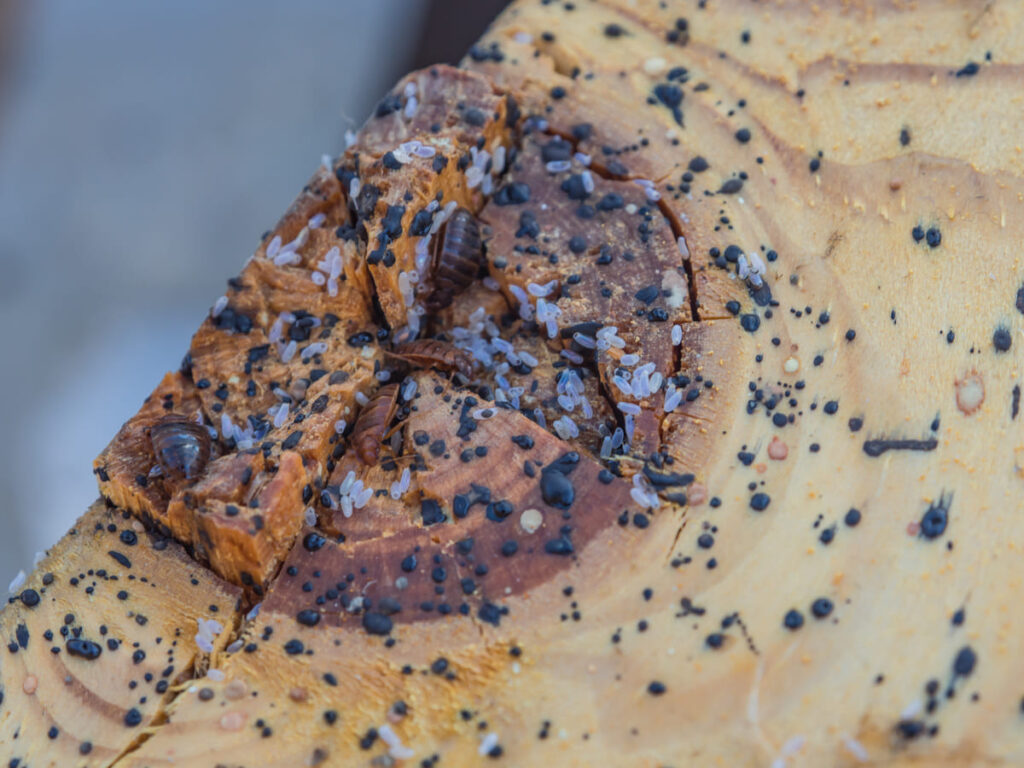
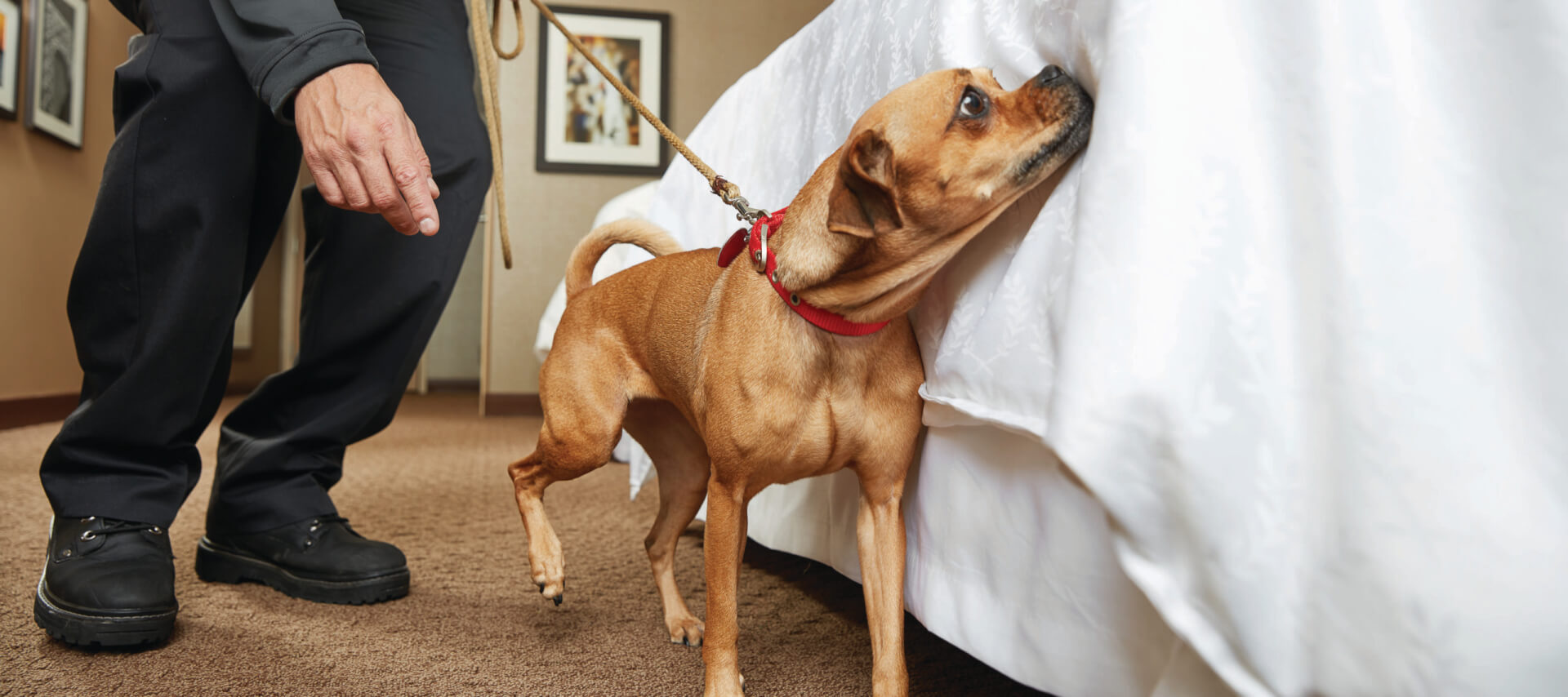
Confirming the presence of bed bugs with dog detection
Dog detection is an effective and increasingly popular method of confirming the presence of bed bugs. Thanks to their exceptional sense of smell, trained dogs are able to spot bedbugs, even when they are hiding in hard-to-reach places.
Unlike a manual inspection, which can be long and tedious, a detection dog can inspect a room in just a few minutes. What’s more, dogs can target infested areas precisely, reducing the need for widespread, often costly, treatment.
Dog detection is particularly useful for early infestations, where other visual signs (eggs, droppings, moults) are still difficult to spot.
Once the bedbugs have been located, the professional will propose a suitable treatment plan.

